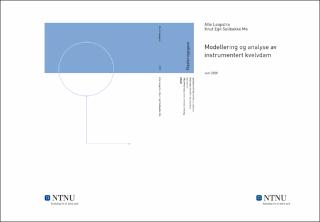| dc.contributor.advisor | Øverli, Jan Arve | |
| dc.contributor.advisor | Lia, Leif | |
| dc.contributor.author | Loopstra, Atle | |
| dc.contributor.author | Mo, Knut Egil Solibakke | |
| dc.date.accessioned | 2021-09-21T16:08:55Z | |
| dc.date.available | 2021-09-21T16:08:55Z | |
| dc.date.issued | 2020 | |
| dc.identifier | no.ntnu:inspera:56731605:25679811 | |
| dc.identifier.uri | https://hdl.handle.net/11250/2780002 | |
| dc.description.abstract | Føremålet med denne oppgåva er å modellere og analysere ein kvelvdam frå 1940-talet med omfattande instrumentering. Instrumenteringa omfattar fire deformasjonskablar som målar forskyvingar over damhøgda, termometer, poretrykksmålarar, monitoreringsprisme og vasstandsovervaking. Måledataa frå desse instrumenta er brukt i modelleringsarbeidet til å fastsetje laster og for å verifisere og tolke resultata.
Modellering og analyse er utført med elementanalyse-programmet DIANA. Tre variantar av modellen er nytta: ein lineær modell, ein ikkje-lineær modell utan fjellvolum og ein ikkje-lineær modell inkludert fjellvolum. Ikkje-lineariteten som er innført, er randvilkår mellom dam og fjell bygd på Coloumb-friksjon med ei maksimal tillaten strekkspenning med påfølgjande sprøtt brot ved overskridande spenningsverdiar.
For lasttilfellet med vasstrykk vert forskyvingsbiletet gjenskapt til ein viss grad. Berekna forskyving er nærare målt forskyving på høgre side og midt på kvelvet enn på venstre side (sett i medstraums retning). Dette tyder på at modellen underestimerer stivleiken i overgangen mellom kvelv og fjell i forhold til mellom kvelv og gravitasjonsdam. For lasttilfella med ekstrem sommar- og vintertemperatur, er avviket mellom berekna og målt forskyving større, både i form og storleik. Dette reflekterer usikkerheita i materialparametrar og uvissheit kring temperaturfordeling i vatnet og i betongen. Resultata impliserer at spenningsfri temperatur for dammen ligg nærare sommarmiddeltemperaturen enn årsmiddeltemperaturen.
Etablering av ikkje-lineære randvilkår gir ikkje ein vesentleg endring i forskyvingsbiletet for kvelvet. Dette gjeld både med og utan fjellvolum. Endringa i resultat kan dermed ikkje forsvare den auka berekningstida ein ikkje-lineær analyse fører med seg. Med ikkje-lineære randvilkår vert modellen særleg sensitiv for endringar i poretrykk, der relativt små krefter gir store strekksoner under fundamentet og ein ustabil modell. Dette tyder på at oppløftskreftene på grunn av poretrykk i realiteten er små.
Instrumenteringa opnar moglegheita for å samanlikne, vurdere og kalibrere parametrar for ein elementmodell, og er eit godt hjelpemiddel ved modellering og verifisering. Oppførselen til kvelvdammen er likevel kompleks og det er vanskeleg å isolere innverknaden til enkeltparametrar. | |
| dc.description.abstract | The objective of this thesis is to model and analyse an arch dam constructed in the 1940s. The dam has extensive instrumentation, including four cables measuring displacements over the height of the dam, thermometers, pressure sensors measuring pore pressures, monitoring prisms and water level monitoring. The data from the measurements is used in the modelling process to establish loads and to verify and interpret the results.
Modelling and analysis are performed with the finite element analysis software DIANA. Three variants of the model are used: a linear model, a non-linear model without bedrock and a non-linear model with bedrock included. The non-linearity that is introduced lies in the connection between the dam and the bedrock. A boundary condition based on Coloumb friction, with a maximum allowed tension stress value with following brittle failure if the stresses surpass the threshold value, is employed.
For the load case with hydrostatic pressure, the displacements match the measured displacements to some degree. The calculated displacements match the measured displacements better on the right side and in the middle of the arch, than on the left side (as seen from upstream). This implies that the model underestimates the stiffness in the connection between the arch and the bedrock on the left compared to the stiffness between the arch and the gravity dam on the right. For the load cases with extreme summer and winter temperatures, the discrepancy between calculated and measured displacements is larger. This reflects the uncertainties in the material parameters and the temperature distribution in the concrete. The results imply that the dam is closer to its stress-free temperature state when subjected to the average summer temperature than for the average annual temperature.
The non-linear boundary condition does not give a significant change in the displacements or the displacement distribution for the arch. This holds both with and without the inclusion of bedrock. The differences in results cannot justify the increase in computational effort that follows a non-linear analysis. With non-linear boundary conditions, the model became especially sensitive for changes in the pore pressure, with relatively small forces yielding considerable tension zones under the foundation and an unstable model. This implies that the uplift forces due to pore pressure are small.
The data from the instrumentation offer the opportunity to compare, validate and calibrate parameters for a finite element model, and is a useful tool for modelling and verification. However, the behaviour of the arch dam is complex, and it is not straightforward to isolate the influence of single parameters. | |
| dc.language | | |
| dc.publisher | NTNU | |
| dc.title | Modellering og analyse av instrumentert kvelvdam | |
| dc.type | Master thesis | |
